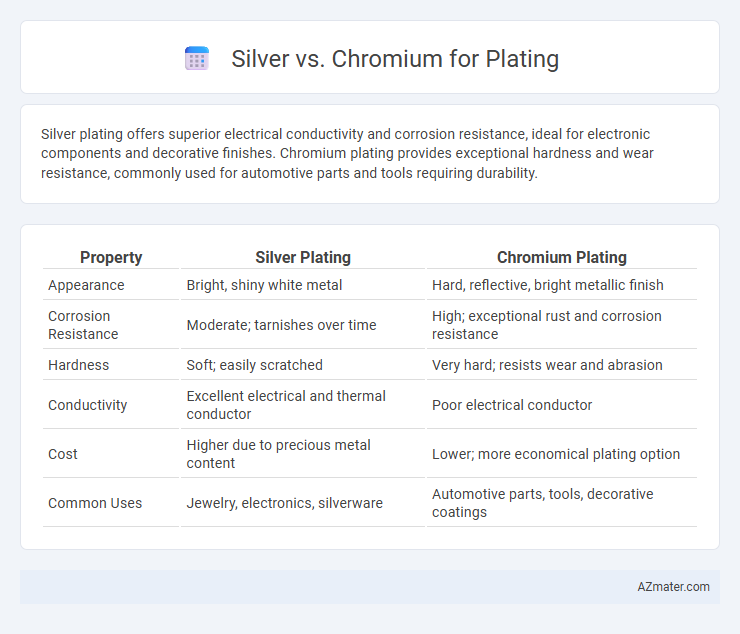Silver plating offers superior electrical conductivity and corrosion resistance, ideal for electronic components and decorative finishes. Chromium plating provides exceptional hardness and wear resistance, commonly used for automotive parts and tools requiring durability.
Table of Comparison
| Property | Silver Plating | Chromium Plating |
|---|---|---|
| Appearance | Bright, shiny white metal | Hard, reflective, bright metallic finish |
| Corrosion Resistance | Moderate; tarnishes over time | High; exceptional rust and corrosion resistance |
| Hardness | Soft; easily scratched | Very hard; resists wear and abrasion |
| Conductivity | Excellent electrical and thermal conductor | Poor electrical conductor |
| Cost | Higher due to precious metal content | Lower; more economical plating option |
| Common Uses | Jewelry, electronics, silverware | Automotive parts, tools, decorative coatings |
Introduction to Plating: Silver vs Chromium
Silver and chromium are both popular metals used in plating to enhance durability, corrosion resistance, and aesthetic appeal. Silver plating offers excellent electrical conductivity and a bright, reflective finish, making it ideal for electronic components and decorative items. Chromium plating provides superior hardness, scratch resistance, and a sleek, mirror-like surface that is highly valued in automotive and industrial applications.
Chemical Properties and Composition
Silver exhibits excellent electrical conductivity and resistance to oxidation due to its atomic structure and is primarily composed of pure elemental silver (Ag). Chromium offers superior hardness and corrosion resistance, largely due to the formation of a stable, inert chromium oxide (Cr2O3) layer on its surface. The chemical properties of silver favor conductivity and aesthetics, while chromium's composition promotes durability and resistance to chemical degradation in plating applications.
Surface Finish and Aesthetic Appeal
Silver plating offers a brilliant, highly reflective surface finish with a warm white luster that enhances aesthetic appeal, making it ideal for decorative items and jewelry. Chromium plating provides a durable, mirror-like finish with a cool, metallic sheen, prized for automotive trim and industrial applications requiring corrosion resistance. Silver's softness can lead to tarnishing and wear, whereas chromium's hardness delivers long-lasting shine and resistance to scratches.
Durability and Corrosion Resistance
Silver plating offers excellent electrical conductivity but is softer and prone to tarnishing, reducing its durability and corrosion resistance. Chromium plating provides superior hardness and exceptional corrosion resistance, forming a protective oxide layer that enhances longevity in harsh environments. Industrial applications often prefer chromium plating for its robust durability and ability to withstand wear and chemical exposure.
Conductivity and Functional Applications
Silver offers superior electrical conductivity, making it ideal for electronic connectors, circuit boards, and high-frequency components where efficient signal transmission is critical. Chromium, although less conductive, provides excellent corrosion resistance and hardness, which suits it for decorative finishes, wear-resistant coatings, and automotive parts. Choosing between silver and chromium plating depends on whether conductivity or durability and aesthetic appeal are the primary functional requirements.
Cost Comparison: Silver vs Chromium Plating
Silver plating generally costs more than chromium plating due to the higher price of silver metal and its complex application process. Chromium plating offers a more economical solution with lower material costs and faster plating times, making it ideal for large-scale industrial use. The price difference is significant in applications requiring extensive surface coverage or thicker layers, where chromium plating delivers cost-effective durability.
Environmental and Health Considerations
Silver plating offers lower toxicity and fewer environmental hazards compared to chromium plating, as silver is less likely to release harmful compounds into ecosystems during disposal or wear. Hexavalent chromium, commonly used in plating, poses significant health risks such as respiratory issues, skin irritation, and carcinogenic effects, necessitating strict regulatory controls. Waste management for chromium plating requires specialized treatment to mitigate its environmental impact, whereas silver plating waste is generally easier to recycle and manage safely.
Maintenance and Longevity
Silver plating requires regular cleaning and polishing to prevent tarnish and maintain its bright luster, as it is prone to oxidation over time. Chromium plating offers superior durability and corrosion resistance, making it low-maintenance and ideal for long-term protection against wear and environmental factors. The longevity of chromium plating typically exceeds that of silver due to its harder surface and resistance to fading or discoloration.
Industry-Specific Uses and Preferences
Silver plating is widely preferred in the electronics industry for its excellent electrical conductivity and corrosion resistance, making it ideal for connectors and circuit boards. Chromium plating dominates automotive and decorative industries due to its hardness, wear resistance, and striking mirror-like finish that enhances durability and aesthetics. Industrial machinery often favors chromium for components requiring high abrasion resistance, whereas silver plating suits precision instruments needing superior conductivity and anti-tarnish properties.
Choosing the Right Plating: Key Factors
Choosing the right plating between silver and chromium depends on factors such as corrosion resistance, conductivity, and aesthetic appeal. Silver plating offers superior electrical conductivity and a bright, reflective finish ideal for electronic components and jewelry, while chromium plating provides exceptional hardness, abrasion resistance, and a sleek, durable surface commonly used in automotive and industrial applications. Considering the intended use environment, required durability, and cost-effectiveness are crucial for making an informed decision between silver and chromium plating.

Infographic: Silver vs Chromium for Plating
 azmater.com
azmater.com